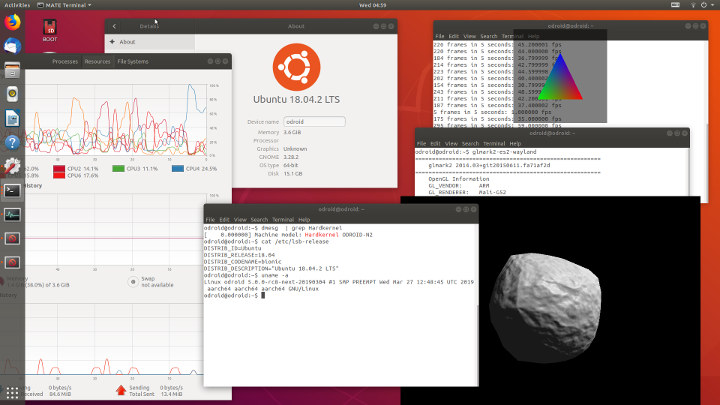ODROID-N2 was announced last February for $63 (2GB RAM), and $79 (4GB RAM), but Hardkernel was not quite ready to take orders at the time. One of the good news is that the 4GB RAM is now available for pre-order with shipping scheduled to start on April 3.
Another good news is on the software side with Hardkernel having released the userland Mali-G52 Wayland driver. It does not work well with Linux 4.9 due to incomplete DRM implementation, but it goes work with Linux 5.0 plus some modifications as further discussed in the aforelinked forum thread.

The screenshot above, courtesy of odroid forum member memeka , shows ODROID-N2 running Ubuntu 18.04 + Gnome3 + Linux 5.0 on top of Wayland with GPU drivers providing acceleration as shown by glmark2-es2-wayland test program.
The benchmark results are pretty impressive:
|
1 2 3 4 5 6 7 8 9 10 11 12 13 14 15 16 17 18 19 20 21 22 23 24 25 26 27 28 29 30 31 32 33 34 35 36 37 38 39 40 41 42 43 44 |
======================================================= glmark2 2014.03+git20150611.fa71af2d ======================================================= OpenGL Information GL_VENDOR: ARM GL_RENDERER: Mali-G52 GL_VERSION: OpenGL ES 3.2 v1.r16p0-01rel0.2943fc4ef9657d91ee32c9a58dec6cd2 ======================================================= [build] use-vbo=false: FPS: 961 FrameTime: 1.041 ms [build] use-vbo=true: FPS: 1592 FrameTime: 0.628 ms [texture] texture-filter=nearest: FPS: 1491 FrameTime: 0.671 ms [texture] texture-filter=linear: FPS: 1477 FrameTime: 0.677 ms [texture] texture-filter=mipmap: FPS: 1524 FrameTime: 0.656 ms [shading] shading=gouraud: FPS: 1151 FrameTime: 0.869 ms [shading] shading=blinn-phong-inf: FPS: 1215 FrameTime: 0.823 ms [shading] shading=phong: FPS: 1043 FrameTime: 0.959 ms [shading] shading=cel: FPS: 1126 FrameTime: 0.888 ms [bump] bump-render=high-poly: FPS: 514 FrameTime: 1.946 ms [bump] bump-render=normals: FPS: 1976 FrameTime: 0.506 ms [bump] bump-render=height: FPS: 1777 FrameTime: 0.563 ms [effect2d] kernel=0,1,0;1,-4,1;0,1,0;: FPS: 1139 FrameTime: 0.878 ms [effect2d] kernel=1,1,1,1,1;1,1,1,1,1;1,1,1,1,1;: FPS: 383 FrameTime: 2.611 ms [pulsar] light=false:quads=5:texture=false: FPS: 2096 FrameTime: 0.477 ms [desktop] blur-radius=5:effect=blur:passes=1:separable=true:windows=4: FPS: 389 FrameTime: 2.571 ms [desktop] effect=shadow:windows=4: FPS: 788 FrameTime: 1.269 ms [buffer] columns=200:interleave=false:update-dispersion=0.9:update-fraction=0.5:update-method=map: FPS: 103 FrameTime: 9.709 ms [buffer] columns=200:interleave=false:update-dispersion=0.9:update-fraction=0.5:update-method=subdata: FPS: 129 FrameTime: 7.752 ms [buffer] columns=200:interleave=true:update-dispersion=0.9:update-fraction=0.5:update-method=map: FPS: 158 FrameTime: 6.329 ms [ideas] speed=duration: FPS: 356 FrameTime: 2.809 ms [jellyfish] <default>: FPS: 979 FrameTime: 1.021 ms [terrain] <default>: FPS: 52 FrameTime: 19.231 ms [shadow] <default>: FPS: 437 FrameTime: 2.288 ms [refract] <default>: FPS: 88 FrameTime: 11.364 ms [conditionals] fragment-steps=0:vertex-steps=0: FPS: 1769 FrameTime: 0.565 ms [conditionals] fragment-steps=5:vertex-steps=0: FPS: 1769 FrameTime: 0.565 ms [conditionals] fragment-steps=0:vertex-steps=5: FPS: 1853 FrameTime: 0.540 ms [function] fragment-complexity=low:fragment-steps=5: FPS: 1783 FrameTime: 0.561 ms [function] fragment-complexity=medium:fragment-steps=5: FPS: 1726 FrameTime: 0.579 ms [loop] fragment-loop=false:fragment-steps=5:vertex-steps=5: FPS: 1715 FrameTime: 0.583 ms [loop] fragment-steps=5:fragment-uniform=false:vertex-steps=5: FPS: 1650 FrameTime: 0.606 ms [loop] fragment-steps=5:fragment-uniform=true:vertex-steps=5: FPS: 1728 FrameTime: 0.579 ms ======================================================= glmark2 Score: 1119 ======================================================= |
I’ve never seen such as high score (1,119 points) on Arm hardware. But at the same time, I’ve never run the wayland version of the benchmark, so that may partially explain it. For reference, RockPro64 RK3399 SBC gets 48 points in the onscreen test (default), and 201 points in the offscreen test. I could not find results for glmark2-es2-wayland for Rockchip RK3399 despite being supported. So we’ll have to see what part of the much higher score is part of the Mali-G52MP GPU, and which part is the use of Wayland over Xorg/X11.

Jean-Luc started CNX Software in 2010 as a part-time endeavor, before quitting his job as a software engineering manager, and starting to write daily news, and reviews full time later in 2011.
Support CNX Software! Donate via cryptocurrencies, become a Patron on Patreon, or purchase goods on Amazon or Aliexpress




